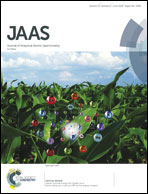Determination of strontium 90 in environmental samples by triple quadrupole ICP-MS and its application to Fukushima soil samples
Abstract
The determination of 90Sr by ICP-MS is capable of providing a high sample throughput compared with radiometric analytical methods. Although the isobaric interference caused by 90Zr ions can be reduced by reaction with oxygen, the high background caused by stable 88Sr has made it difficult to determine 90Sr by conventional ICP-MS. In this study, a rapid and sensitive method was developed for the determination of 90Sr using triple quadrupole ICP-MS. The MS/MS configuration improves the abundance sensitivity by more than two orders of magnitude (5 × 10−12), and the detection limit for 90Sr in 1 g environmental samples was 0.6 Bq kg−1. The applicability of the method to the measurement of 90Sr in environmental samples was demonstrated by analysis of certified reference materials (soil: IAEA 375; plant: IAEA 330, IAEA 373) contaminated by the Chernobyl accident. The measured 90Sr radioactivities in the samples were consistent with values determined by radiometric analysis, within analytical error. The measured 90Sr concentration in IAEA 372 was 610 ± 40 Bq kg−1 (SD, n = 3) (Decay correction was made to December 1, 2016). This method provides a powerful tool for the investigation of radiostrontium contaminations in the Fukushima area and elsewhere.



 Please wait while we load your content...
Please wait while we load your content...